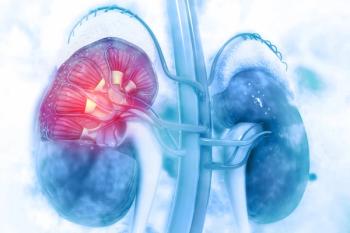
Background: Lenvatinib + Pembrolizumab or Everolimus for Advanced Renal Cell Carcinoma
Robert J. Motzer, MD, presents data examined in the article, “Lenvatinib Plus Pembrolizumab or Everolimus for Advanced Renal Cell Carcinoma.”
Episodes in this series

Robert J. Motzer, MD: Welcome to this CancerNetwork® Between the Lines program. Today’s featured article is, “Lenvatinib Plus Pembrolizumab or Everolimus for Advanced Renal Cell Carcinoma.” I’m Robert Motzer, a medical oncologist at Memorial Sloan Kettering Cancer Center [New York, New York]. I’ll be discussing this paper with my colleague at Memorial, Marie Carlo, [MD].
The CLEAR study was a randomized phase 3 trial that compared lenvatinib plus pembrolizumab to sunitinib, and lenvatinib plus everolimus to sunitinib. This study was done in patients who were treatment-naive and had advanced clear cell RCC [renal cell carcinoma] with measurable disease and adequate performance status and organ function. The randomization was 1:1:1 to lenvatinib at 20 mg PO [orally] per day, plus pembrolizumab at 200 mg IV [intravenous] every 3 weeks versus lenvatinib 18 mg [orally] per day, plus everolimus 5 mg [orally] per day, compared to sunitinib at the standard 50 mg orally 4-week-on, 2-week-off schedule. The primary end point was progression-free survival [PFS] by an independent radiologic review committee, and key secondary end points included overall survival, objective response rate, safety, and patient-reported outcomes.
This trial met both of its primary end points showing improvement in progression-free survival for lenvatinib plus pembrolizumab compared to sunitinib, and for lenvatinib plus everolimus compared to sunitinib. The median progression-free survival for lenvatinib plus pembrolizumab was 23.9 months, and the hazard ratio of a benefit in PFS versus sunitinib was 0.39. This was statistically significant. For lenvatinib plus everolimus, the median progression-free survival was 14.7 months compared to the 9.2 months with sunitinib, and the hazard ratio was 0.65, also statistically significant. Both lenvatinib arms met the primary end point by showing improvement in PFS compared to sunitinib, but lenvatinib plus pembrolizumab was the most robust in terms of showing a dramatic improvement in efficacy in progression-free survival compared to sunitinib, of a higher magnitude than lenvatinib plus everolimus. Overall survival was a key secondary end point. At the time of the analysis, there was a benefit in lenvatinib plus pembrolizumab compared to sunitinib.
Objective response rates were higher with lenvatinib plus [pembrolizumab] and with lenvatinib plus everolimus compared to sunitinib. The objective response rate for lenvatinib plus pembrolizumab was 71%. At the time of this analysis, the complete response proportion was 16%. For lenvatinib plus everolimus, again, a higher response rate than sunitinib, but not as robust. The objective response rate was 53.5% for lenvatinib plus everolimus compared to 36% with sunitinib. The proportion of patients who achieved a complete response was 9.8%. One of the features that characterizes lenvatinib plus pembrolizumab in its robust activity, in addition to the long progression-free survival, the overall survival benefit, and the high objective response rate, is the duration of responses that we saw with this program. The median duration of response for lenvatinib plus pembrolizumab was 25.8 months compared to 14.6 months with sunitinib.
Adverse events for lenvatinib plus pembrolizumab and lenvatinib plus everolimus were seen in nearly all patients treated on the trial as they were for the sunitinib-treated patients. The most common adverse events that we saw with the lenvatinib-containing arms were driven by the tyrosine kinase inhibitor [TKI] lenvatinib. These included diarrhea, hypertension, fatigue, and stomatitis. One of the features that was notable for lenvatinib plus pembrolizumab was that there was a very low proportion of patients who had hepatic toxicity. Hepatic toxicity has been problematic with other TKI/IO [immunotherapy] combinations. One of the features of lenvatinib is it has a low rate of liver toxicity. For the most part, the toxicity that we do see with lenvatinib, that characterizes this compound, is proteinuria, which does occur at higher rates with lenvatinib than with other TKIs. The proportion of patients who develop grade 3 or higher proteinuria with lenvatinib plus pembrolizumab was 7.7%. In general, the adverse events seemed higher with lenvatinib plus everolimus compared to lenvatinib plus pembrolizumab. The lenvatinib plus pembrolizumab was in general a relatively well-tolerated program with a TKI plus IO. There were very few immune-related adverse events with this program.
The takeaway from the trial is that both arms met progression-free survival benefit, but lenvatinib plus pembrolizumab was the only treatment arm to show a benefit in overall survival.
Transcript edited for clarity.
Newsletter
Stay up to date on recent advances in the multidisciplinary approach to cancer.


























































































